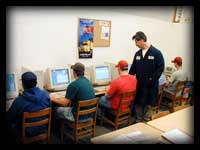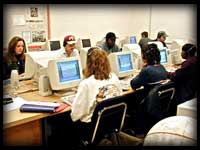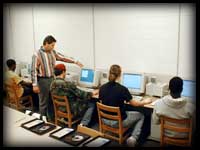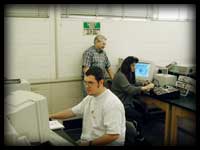The computer network
began with a plan laid out by the Institutional Technology Committee to install
fiber-optic cable throughout the campus, to allow for a Cat5 cable network
drop in every office and every lab workstation. Bids were sent out to several
companies, with the final award going to J. Mike Enterprises. The campus networking
began in October '98 and was completed by January '99. In many cases, the
cabling involved boring underground to extend the network to all buildings
on campus. Despite digging up concrete, J. Mike Enterprises finished on-schedule,
with Internet access now available to all faculty & staff offices and
computer labs.




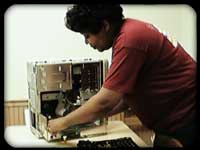



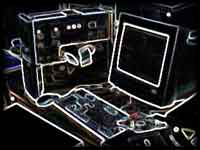
The
MacArthur State Windows NT 4.0 network consists of a PDC (Primary Domain Controller)
and a BDC (Backup Domain Controller), and multiple Member Servers located in
different departments. The PDC and BDC house all user identities, and the BDC
also serves as the DHCP and WINS server. Member Servers around the campus mainly
serve as application and file servers for student labs. The campus currently
has over 250 Dell Optiplex PC's of various configurations, depending upon what
year of the grant they were purchased. They range from 350MHz PC's purchased
year one, to 500MHz PC's in year two, and 1.0GHz PC's to be purchased year three.
Establishing the campus network in the first two years of the grant will allow
the completion of year 3, 4 & 5 goals to implement computer-based and distance
learning education.
The
T3 Team installed the Automotive & Diesel Mechanics Lab in 1999. Students
use a variety of simulator software to learn about engines, safety, and electronics.
The
General Studies 25-PC Lab, installed Year 2, is the largest lab installed by
Title 3. There is an application server located in the lab, and students use
network-based applications such as Learning 100, Boxer Mathematics Software,
and Skills Bank.
Also
in Year 2 the Title 3 Team installed the Carpentry and Cabinetmaking Lab. Students
use software to learn how to calculate construction materials and cost estimates.
Additionally, they use 3-D Home Architect to lay out floor plans to conceptualize
what a building will look like when completed.
The
Industrial Electronics Lab encompasses the first three years of the grant, purchasing
5 PC's and 5 simulator units & software each of the first 3 years. The lab
incorporates NIDA simulator hardware and software, identical to training units
used by the Air Force.



